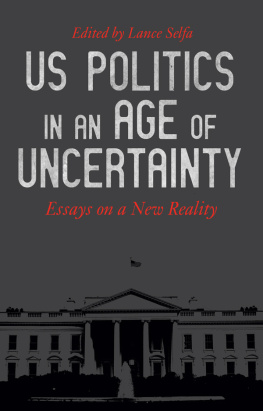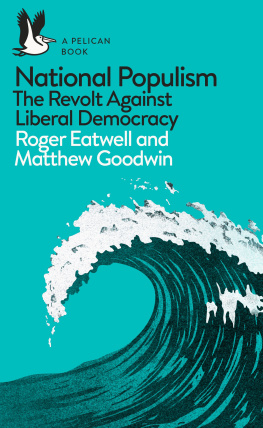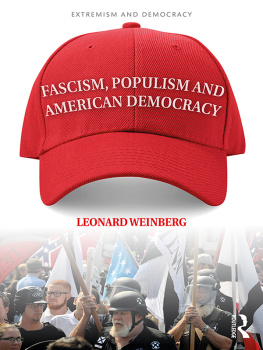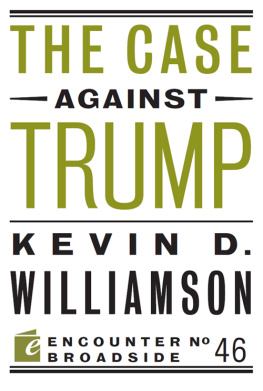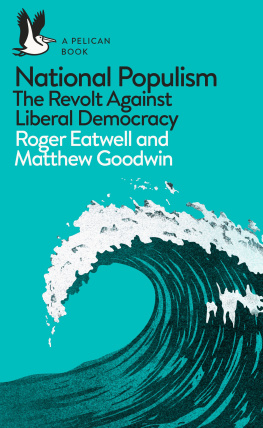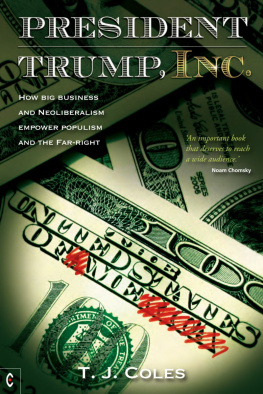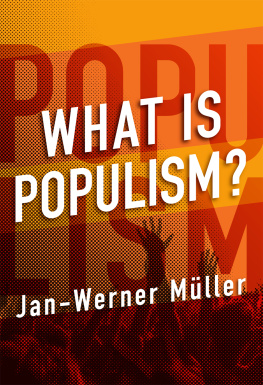US POLITICS IN AN
AGE OF
UNCERTAINTY
US POLITICS IN AN
AGE OF
UNCERTAINTY
ESSAYS ON A NEW REALITY
Edited by Lance Selfa

2017 Lance Selfa
Published in 2017 by
Haymarket Books
P.O. Box 180165
Chicago, IL 60618
773-583-7884
www.haymarketbooks.org
ISBN: 978-1-60846-874-4
Trade distribution:
In the US, Consortium Book Sales and Distribution, www.cbsd.com
In Canada, Publishers Group Canada, www.pgcbooks.ca
In the UK, Turnaround Publisher Services, www.turnaround-uk.com
All other countries, Ingram Publisher Services International,
This book was published with the generous support of Lannan Foundation and Wallace Action Fund.
Cover design by Rachel Cohen.
Library of Congress Cataloging-in-Publication data is available.

INTRODUCTION
Months after the event, the Electoral Colleges selection of Donald Trump as 45th president of the United States still has the power to shock on many levels. A transition from the first African American president to someone who made racism a cornerstone of his campaign is one element. Another is the fact that Trump triumphed against what appeared to be a solid popular front of most of American business, the media, the political establishment, and liberal activists lined up behind Democrat Hillary Clinton. Despite all of these factorsor perhaps, more accurately, because of themthe United Statess dysfunctional political system delivered the worlds most powerful office to the loser of the national popular vote for the second time in sixteen years.
Trumps election blindsided the political and media establishment. Even most of us on the leftwho are much more attuned to the economic wreckage and despair on which Trump built his appealconsidered Trumps election a distant prospect. The International Socialist Reviews first postelection editorial noted:
Very few of us on the left expected that the next president of the United States would be a corrupt, narcissistic billionaire swindler, an open sexist and self-confessed serial abuser, and a man the Far Right hails for his open racism and nationalist xenophobia. Donald Trump successfully positioned himself as a right-wing populist, anti-establishment candidate who would tear up free trade, deport immigrant job-stealers, and restore good jobs for real Americans. And it worked.
With this in mind, Haymarket Books decided to publish this reader. Weve brought together contributions, written by socialists, on different aspects of US politics in this era of transition from Obama to Trump. Many of these texts appeared originally in publications such as International Socialist Review, Jacobin, Dissent, or Catalyst. Others are original to this volume. Although some of them were written or published after Trumps election, they generally do not speculate about the future course of a Trump administration. Instead, they attempt, as Trotsky once wrote, to look reality in the face, in order to develop an understanding of what happened in 2016.
To be sure, each writer has a particular perspective on the election. And each emphasizes different points. And while the authors may not agree on each point, the collection develops general themes. One of these is the corrosive impact that forty years of free market policy and ideology, known as neoliberalism, has had on living standards and political imagination. Neoliberalism has devastated working-class lives and organizations, and narrowed mainstream political choices to liberal and right-wing populist versions of the same basic economic program.
Sharon Smith and Lance Selfa show how the Democratic Partys commitment to the neoliberal status quo, along with its own failure in government to address the real issues facing working-class Americans of all races and ethnicities, opened the door to Trumps right-wing populism. With the election seemingly offering a choice between a candidate who proclaimed that America is already great (Clinton) and one whohowever disingenuouslypromised to make America great again, millions of voters opted for change. As Neil Davidson points out, this pattern, pitting what Nancy Fraser dubs progressive neoliberalism against right-wing populism, is a worldwide phenomenon, not just one observed in the United States.
Much postelection analysis and commentary focused on defining Trumps base as emanating from what the media and political professionals describe as the white working class, a shorthand for whites without four-year college degrees.
Another tendentious reading of the electionespecially on the liberal side of the political spectrumis the notion that the Democrats lost because they championed identity politics, aimed at attracting groups of Blacks, Latinos, Muslims, women, and LGBTQ people, while eschewing a more inclusive class politics. Most authors in this collection would disagree with this assessment. Other than projecting a kind of patina of lean-in feminism and the rhetoric of diversity common in Corporate America, Clinton and the Democrats have actually advancedor acceded topolicies that have encouraged mass incarceration, the erosion of abortion rights, Islamophobia, and mass deportations.
Keeanga-Yamahtta Taylors essay shows how Obamas presidency was not a gift to African Americans; instead, it represented the painful continuity of racism, discrimination, and inequality that has always been at the center of Black life in America. Elizabeth Schulte contends that, while Trump and many of his Republican cohorts exude contempt for women, the Democrats feeble attempt to pose themselves as the lesser evil on womens rights failed. The interviews with Deepa Kumar and Justin Akers Chacn remind us of how much the Obama and Bill Clinton administrations set in motion, or deepened, many of the policies that promote Islamophobia and border security and have now been placed in the xenophobic Trump administrations hands.
This brief introduction cant do full justice to the detailed and insightful analyses that each of the contributions collected here brings to an understanding of the 2016 election. These essays are offered with the knowledge that the social forces that drove the 2016 election remain with us still. For the left to build organizations and to project politics that can offer a real alternative to the working-class majority, we need to understand what these forces are.
Lance Selfa
October 2017
CHICKENS COMING HOME TO ROOST FOR THE DEMOCRATIC PARTY?
How Neoliberalism Quietly Devastated the US Working Class
Sharon Smith
Amid the shock and horror following Donald Trumps election, mainstream news outlets all sounded the same alarm: white workers were getting their revenge. Indeed, the headlines were stunningly similar. How Trump Won: The Revenge of Working-Class Whites (Washington Post);
In this way, the mainstream media created the postelection narrative, parroting Democratic Party leaders frantically seeking to blame someone (other than themselves) for Hillary Clintons loss. They settled on the slice of white voters in key Midwestern swing states (Iowa, Wisconsin, Michigan, Pennsylvania, and Ohio) who voted for Trump. They labeled these voters working class based on the large number of Trump voters without a college degreedisregarding the fact that his supporters in the 2016
Just weeks after the election, researchers Konstantin Kilibarda and Daria Roithmayr convincingly challenged the medias blame the white working class narrative. After studying the exit poll data in the Rust Belt swing states, they concluded, Relative to the 2012 election, Democratic support in the Rust Belt collapsed as a huge number of Democrats stayed home or (to a lesser extent) voted for a third party. Trump did not really flip white, working-class voters in the Rust Belt. Mostly, Democrats lost them.

